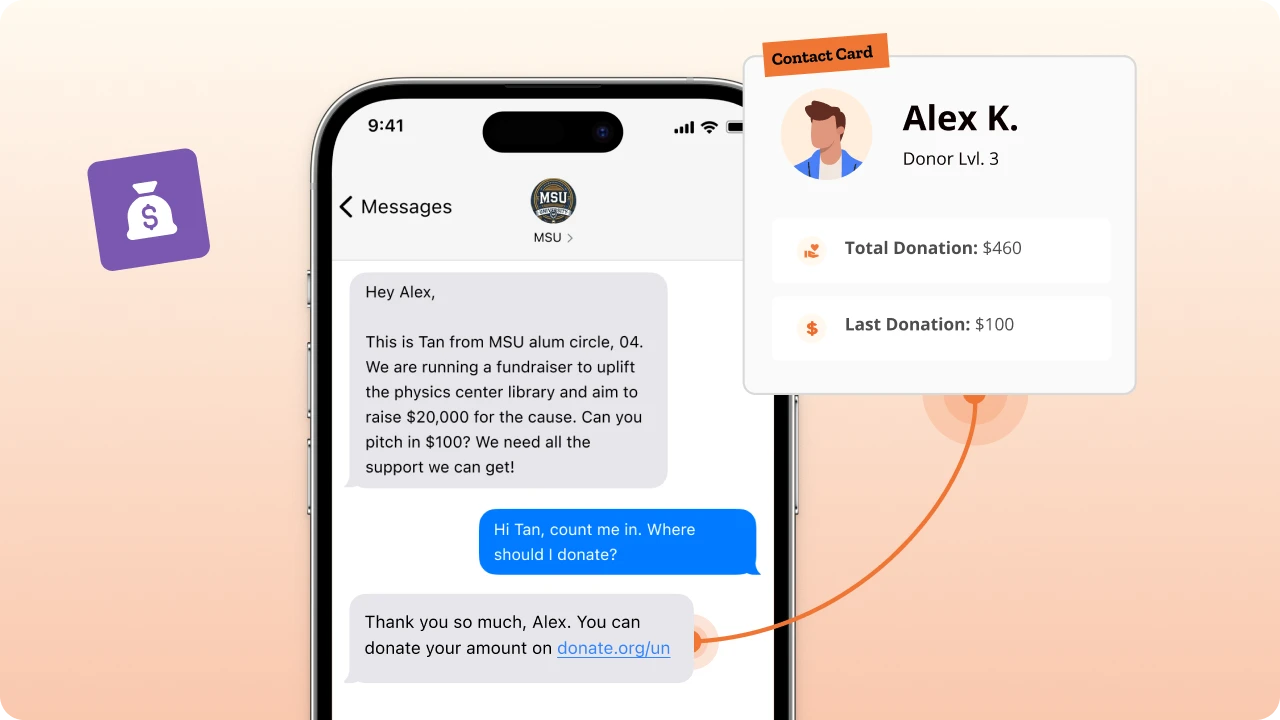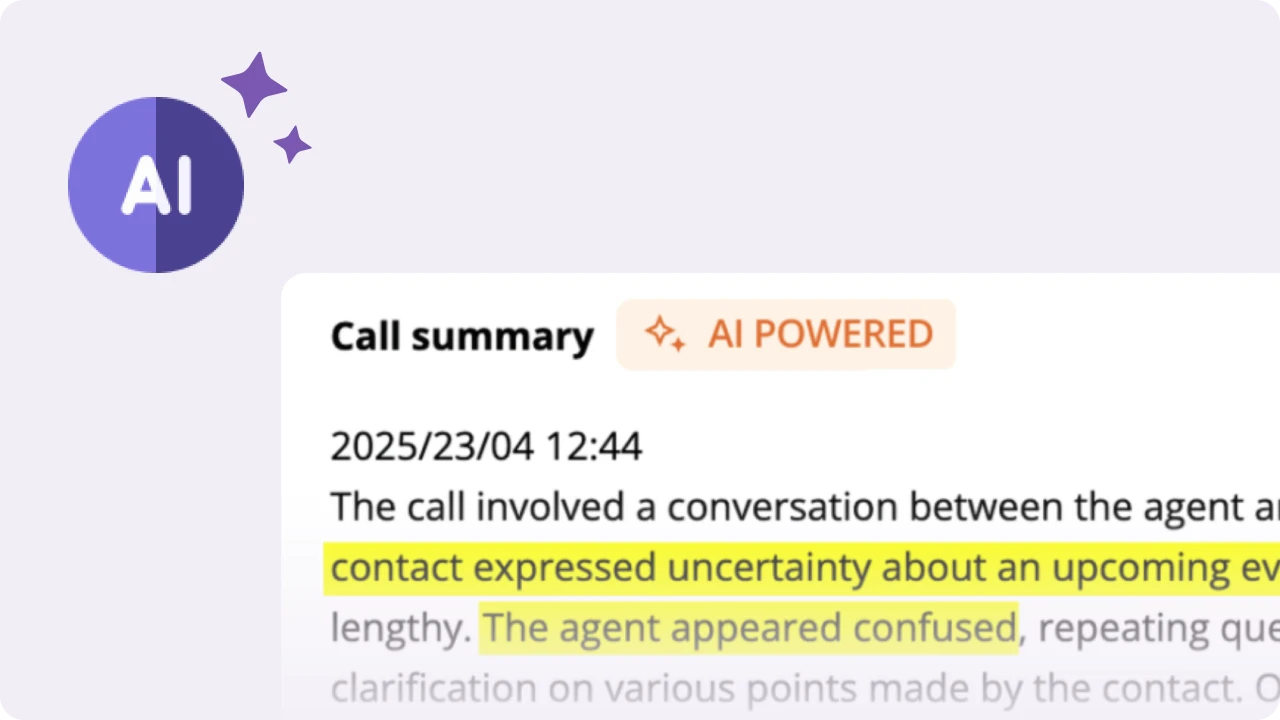Table of Contents
Year end giving refers to the surge of charitable donations made during the final months of the calendar year, especially November and December. This period is often referred to as the “season of giving,” as individuals and businesses are inspired by the holidays, tax planning, and a spirit of generosity to support causes they care about.
Why year end giving matters.
Year end giving is the most lucrative period for nonprofit fundraising. In 2024, U.S. charitable giving reached a record $592.5 billion (a 6.3%increase), with nearly 31% of annual donations occurring in December and 12% in the last three days alone. For nonprofits, this season is a make-or-break opportunity to meet financial goals, engage donors, and build community impact.
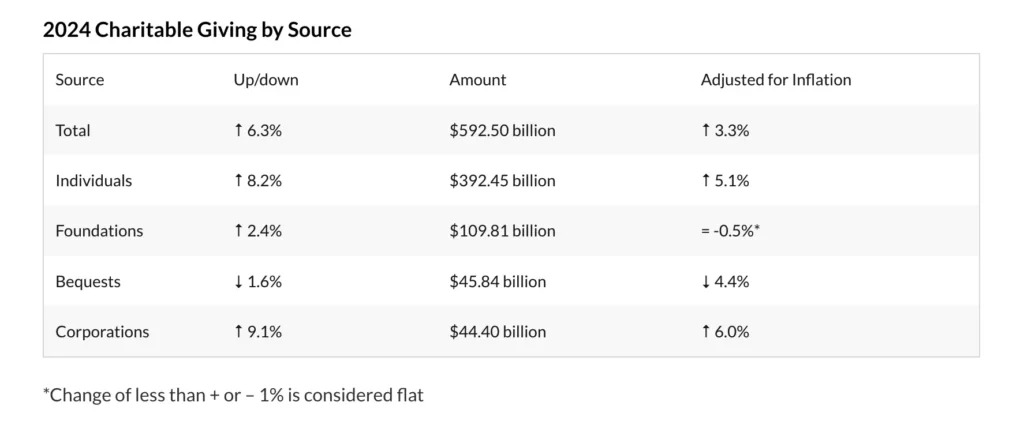
In this guide, you’ll find proven strategies to plan, execute, and wrap up a successful year end giving campaign. One that inspires donors and maximizes impact.
| Did you know? Millennials account for 11% of total charitable giving in the US |
Read more: Corporate giving 2025: How to tap into billions in funding.
What are the benefits of year end giving?
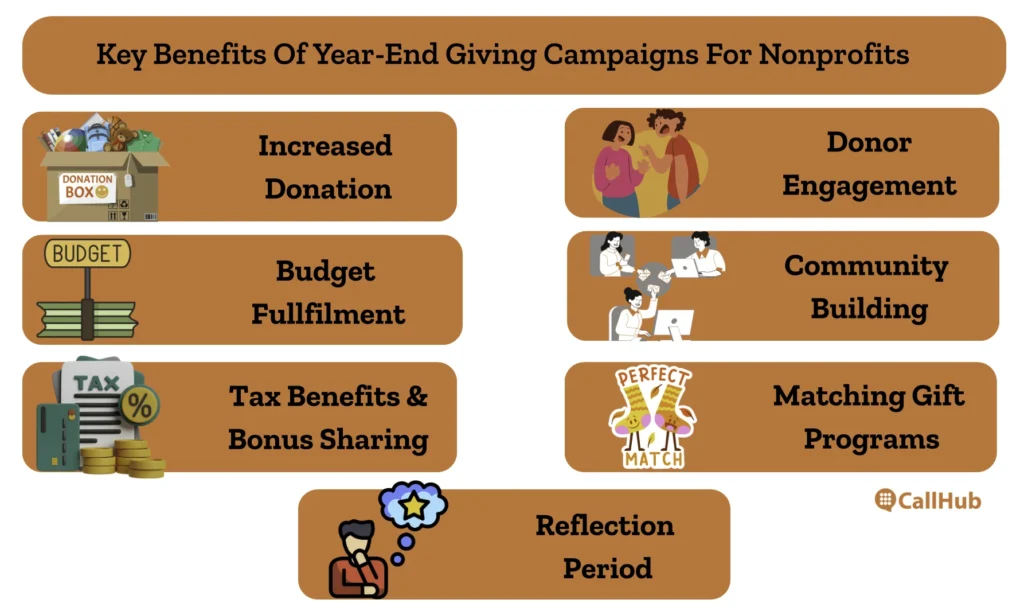
For fundraising professionals like you, year-end campaigns offer more than just a seasonal boost; they solidify year-long strategies and donor relationships.
Here is why a year end giving campaign is crucial:
1. Increased donations
The most obvious benefit is the significant boost in donation volume and total revenue during this peak giving season. Research shows that 33.6% of annual donations in the U.S. occur between Thanksgiving and Christmas. These celebrations inspire giving and generosity amongst donors.
2. Donor engagement
End-of-year campaigns provide excellent opportunities to re-engage lapsed donors and deepen relationships with current supporters through powerful narratives
3. Budget fulfillment
Nearly a quarter of nonprofits rely on year end fundraising for at least half of their annual revenue, making this season crucial for meeting budget targets and securing funds for critical programs in the year ahead.
4. Community building
These campaigns unite supporters around shared causes, creating stronger community bonds and volunteer networks.

CallHub fosters community building by offering a platform where organizers can share tools, ideas, and volunteer opportunities, enabling supporters to connect over shared causes and strengthen their networks.
5. Tax benefits and bonus sharing
Organizations can help donors maximize their tax advantages while meeting their own fundraising goals. Donors save on taxes before they need to file them at the end of the year, giving. Not only that, but many employees receive bonuses that they are willing to share with a good cause.
6. Matching gift programs
Many employers offer year end matching gift opportunities. This helps increase fundraising revenues, enhance donor engagement, improve donor awareness, strengthen corporate relationships, and attract young talent.
7. Reflection period
People evaluate their annual giving and make final contributions. December, for many, is the time to reflect on the yearly goals they achieved and the difference they made in the world.
| Did you know? More than 40% of year end donors make a second gift to the same charity, compared to only 26% of donors who give between January and October. |
8 steps to host a successful year end giving campaign
Here are eight strategic steps that will help you orchestrate a multi-channel approach that maximizes both immediate donations and long-term donor value:

Start early and clear goals for year end giving.
Start planning early with clear goals for year end giving
Early planning gives you time to fine-tune your messaging, prepare campaign assets, and allocate resources where they’ll make the most impact. With CallHub, you can begin setting up outreach templates and scheduling communication workflows well in advance, helping your campaign hit the ground running.
One key to successful campaigns is setting SMART goals.

This ensures your fundraising efforts are focused and trackable. For example, you can set goals like:
- How much funding do you want to raise?
- How many donors do you want to acquire?
- How do you plan to engage current supporters?
Read Also: Maximize Your Impact: How to Set The Right Fundraising Goals
Develop a multi-channel engagement strategy.
Successful year-end campaigns require a well-coordinated strategy that engages prospects across multiple communication channels. Rather than relying on a single method, it’s essential to establish multiple touchpoints across various platforms.
This multichannel approach enhances your chances of effectively connecting with your audience.
The 2020 omnichannel marketing automation statistics report that using three or more channels can result in 287% higher purchase rate compared to single-channel campaigns. While this is primarily aimed at consumers, the broader point remains the same: the more you engage with donors across various platforms, the more likely they are to make a donation.
Your outreach should include:
Year end giving: texting campaigns:
Texting campaign tools help you engage donors quickly and effectively. And there are many forms of messages you can send across various campaigns, like:
- SMS broadcast sends personalized bulk text messages for goal updates (“We have raised $10,000 and we need $10,000 more!”) or announcements.
- Peer-to-peer (P2P) texting enables one-on-one conversations, making engagement more personal and responsive.
- With Text-to-donate, supporters can donate instantly via SMS by texting a keyword to receive a donation link.

4. MMS (Multimedia Messaging Service) shares rich visuals—impact photos, thank-you videos, or infographics illustrating donations in action.
5. RCS (Rich Communication Services) to create interactive, branded donor experiences within text messages using buttons, clickable CTAs, and carousels.
As texting continues to be one of the most preferred communication channels, according to research, using this will ensure your message captures attention and drives action.
Read more: How do you write a fundraising text: 10 easy steps.
Year-end giving: make phone calls for fundraising:
If you want to reach out to major or legacy donors, making a phone call may be one of the most effective ways to get in touch. It allows you to have more extended, more personalized conversations where you can pitch for higher asks.
| Pro-tip: Use dialers such as the preview dialer to make 5x more calls per hour or the predictive dialer to automatically connect with donors when they pick up. These dialers give you a snapshot of the most relevant information about the donors you are calling, so you can tailor your fundraising asks and make it personal. |
Year-end giving: email campaigns
According to NonProfitPRO, nonprofits generated 16% of their online fundraising revenue through email in 2024.
Follow up your fundraising outreach with strategically planned emails throughout the campaign.
Read Also: Tips To Write The Perfect End Of Year Fundraising Email
Segment your donor list.
Instead of a one-size-fits-all approach, segment your donor list based on giving history, demographic data, past engagement, and communication preferences to craft messages that truly resonate.
For example, on CallHub, you can import contact lists from various sources and organize them into detailed segments using custom fields and tags. This allows you to tailor your outreach by grouping donors based on criteria like giving history, demographics, engagement level, or communication preferences.
Personalize your outreach
Personalized messages see a 27% increase in donor retention. Naturally, it is one of the best hacks for your year-end giving campaign.
You can personalize:
- Messages using merge tags (such as first name, city, or donation amount)
- Volunteers can log dispositions (e.g., “Interested,” “No answer”) to track outcomes and trigger follow-ups.
This ensures every message and conversation is relevant, targeted, and effective.
Leverage peer networks for effective outreach.
Emotion drives giving. Use psychological triggers such as:
- Urgency (“only a few days left!”),
- Social proof (“join hundreds of others…”), and
- Impact (”your gift feeds a family for a week”)
to invoke people to take action.
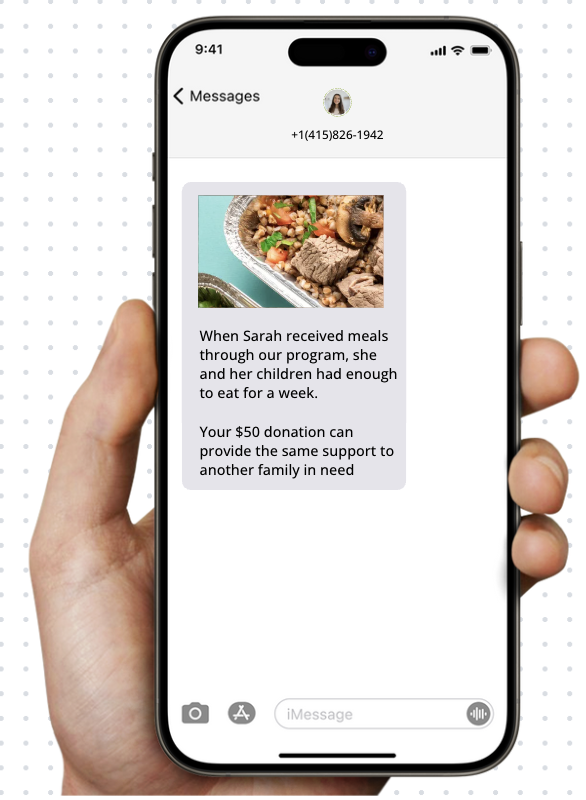
Stories from beneficiaries and clear donation impact statements increase emotional connection and donor motivation.
Optimize the donation page
The average nonprofit donation page sees a 50-70% abandonment rate. Which means, you’ve run a successful campaign, convinced donors, and got them to the donation page somehow—only for 7 out of 10 people to leave without completing their donation. This is why optimizing your donation page matters.
Ensure your donation page is:
- Easy to navigate
- Mobile-friendly
- Loads quickly
- Supports multiple payment methods.
Include one-click donation options in texts and emails, and pre-fill donor information where possible.
Track performance and adjust.
Monitor your campaign metrics as they come in. Metrics like:
- Open rates
- Click-through rates
- Donation amounts
- Audience engagement
These provide valuable insights into what’s working and what needs improvement. The flexibility to adjust creative, targeting, or timing mid-campaign can make a meaningful difference in outcomes.
Integrate with your CRM
Data loss = dollars lost in the fundraising world.
Ensure that it never happens by integrating your outreach platform with a CRM system.
CallHub offers integrations to help streamline data movement between platforms. We integrate with leading CRMs, such as NationBuilder, Blackbaud (including Luminate Online and Raiser’s Edge), Salesforce, NGP VAN, and many more.
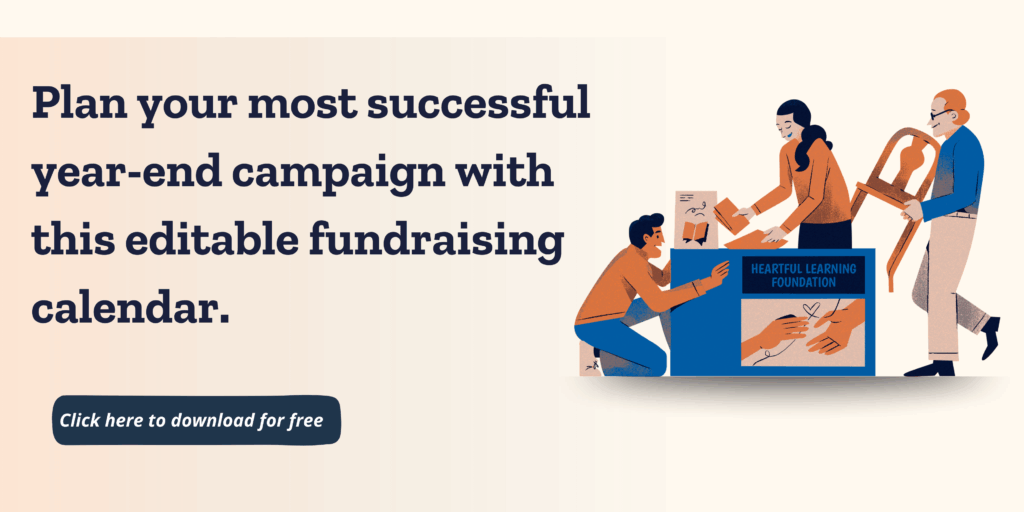
Wrap up your year-end campaign with these four proven tips
The final stage of your year-end campaign is where a strong strategy makes a big difference. These clever closing tactics help you boost last-minute donations and build lasting relationships with your donors:
| Strategy | What to Do | Tips |
| Final push | Create a sense of urgency in the last week of your campaign. | Follow up with: Tailored thank-you messages, updates on how their gift is being used, and regular check-ins. These turn one-time donors into long-term supporters. |
| Donor retention strategy | Thank donors and maintain engagement after their gift. | Follow up with: Tailored thank-you messagesUpdates on how their gift is being usedRegular check-insThese turn one-time donors into long-term supporters. |
| Public recognition | Celebrate campaign success and recognize donors (with permission). | Share impact stories and results across your channels to maintain momentum for future campaigns. |
| Performance review and planning | Analyze campaign performance beyond basic stats | Review the entire donor journey, identify the most effective channels, and evaluate responses from different donor groups to improve your next campaign. |
Expert Hint: Use AI and automation to scale year-end giving
Your donors are hearing from dozens of causes in November and December, so timing and relevance matter more than ever. AI and automation help you stay personal at scale without burning out your team.
- Use Workflow automation to trigger the next best touch automatically based on donor behavior. For example, if someone doesn’t pick up a call, you can automatically send a follow-up text with a donation link, or if they click but don’t give, schedule a reminder email for the next day.
- Let AI-powered insights guide your scripts and targeting for higher year-end ROI. AI tools that services like CallHub offer can summarize donor calls, flag sentiment, and provide a summary, so you can quickly refine your talking points and focus your outreach on the people most likely to convert before December 31.
- Automate thank-yous and stewardship so no donor falls through the cracks. Set up instant SMS acknowledgements after every gift, followed by scheduled impact updates in January, turning one-time year-end donors into long-term supporters with almost no extra lift from your team.
FAQs on Year-end Giving
1. What is the meaning of year-end giving?
Year-end giving is the tradition of making charitable donations during the last months of the year, driven by holiday spirit, tax planning, and a desire to make a positive impact
2. What are the IRS rules for year-end giving?
To qualify, donations must go to registered 501(c)(3) organizations before midnight on December 31. Always retain donation receipts for tax filings.
3. Why do people give at the end of the year?
People give at the year-end due to tax deadlines, holiday bonuses, a spirit of goodwill, and a desire to help others as the year closes.
4. Why do nonprofits always ask for $19 a month?
Nonprofits often ask for $19 a month because it’s a psychologically appealing amount—low enough to feel manageable, yet high enough to make a meaningful monthly impact. It also aligns with IRS reporting, as charities divide the annual donation threshold by 12 and round down, making tracking easier.
Your path to year-end giving success.
A strong year-end giving campaign can transform your nonprofit if you:
- Start early
- Understand your audience
- Leverage multichannel outreach with CallHub
- Focus on nurturing donor relationships.
These steps not only boost donations but also build lasting support for your mission. Take action now and launch your year-end giving campaign with CallHub and make this your most impactful season yet!

